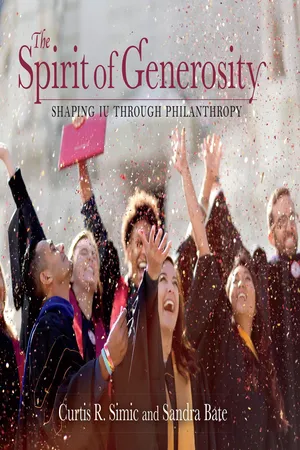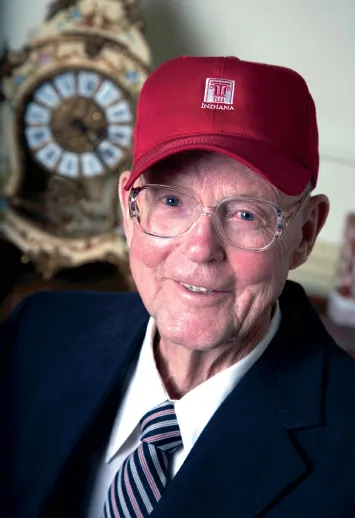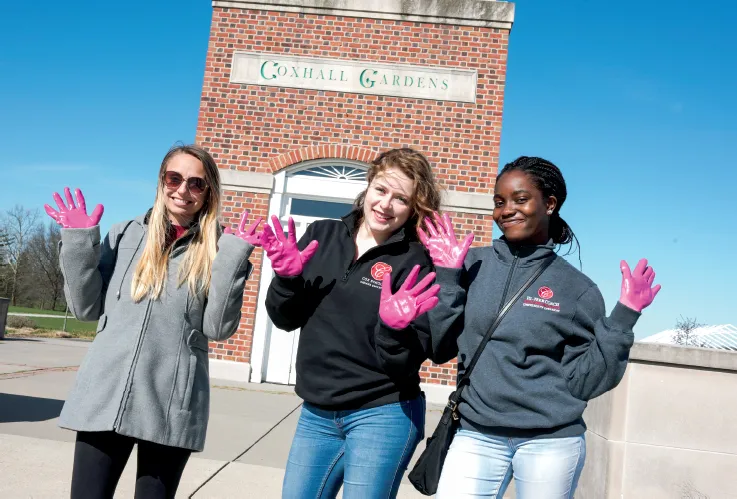![]()
A Commitment to Opportunity
PROVIDING BROAD ACCESS TO EDUCATION AT INDIANA UNIVERSITY
Indiana University’s beloved chancellor emeritus Herman B Wells loved to quote an ancient Chinese proverb: “If you are planning for a year ahead … sow rice. For ten years … plant trees. For a hundred years … educate people.”
Since the 1636 founding of Harvard, America’s first college, the task of offering education to people has included, at its very core, the need to ensure broad access to opportunity. The most superior and beautiful campus, the most highly qualified teaching faculty, the most inspiring curricula are only significant when students have access to the promise of what those components of a university can bring to their lives.
Providing that broad access through scholarships and fellowships is a philanthropic mission that has consistently appealed to Indiana University’s most generous donors. In fact, it is not uncommon to find that many donors first give to scholarship programs, beginning their own philanthropic journeys to open doors of opportunity.
Through gifts that endow financial aid programs, these benefactors assure that today’s students will gain from the wisdom and expertise epitomized on a university campus to prepare for lives of leadership in tomorrow’s global economy.
Photo: Indiana University Foundation
![]()
JESSE H. COX
Of Knowledge, Hard Work, and Self-Confidence
Like others in his generation who experienced the Great Depression firsthand, Jesse H. Cox valued the basics in life: knowledge, hard work, and discipline. And he regarded self-confidence as one of life’s essentials.
A 1944 graduate of Indiana University, Jesse might rightfully be called one of his alma mater’s most quotable alumni. He stated things plainly, to the point, with little fanfare:
• You expect success and it happens.
• The way to build confidence is to do everything you can the very best that you can do it.
• You exude confidence, and people are willing to do, or help you do, what you say you’re going to do.
• Accumulated knowledge is the greatest key to a future of happiness.
Late in his life, after he had given the largest gift in Indiana University history to fund student scholarships, Jesse met with the first selected group of Cox Scholars. These were the first students for whom a college education would become a reality because of Jesse’s generosity.
Jesse was, characteristically, quite quotable that day. In a conference room on the Indiana University Purdue University Indianapolis (IUPUI) campus, he walked to the podium wearing his IU cap, looked out at the dozen or so young faces before him, and said, “I’ve been thinking about you since before you were born.”
Seasons of Giving Back. Each spring, Indiana University Cox Scholars volunteer to travel to Coxhall Gardens to give back, in kind, to Jesse and Beulah Cox. Here, Cox Scholars (l–r) Fatjona Hasani, Casey Stover, and Gbemisola Owolabi take a break during the workday to clean up the park and get it ready for the coming season. The park was a 125-acre gift from the Coxes to preserve an oasis of open spaces, water, and gardens in southwestern Hamilton County. Photo: Cox Scholars Program, Indiana University
Those gathered that day to meet Jesse Cox sensed the authenticity of the man who, through his remarkable philanthropy, made a gift that now assists nearly four hundred students each year at Indiana University.
WORKING HIS WAY
Jesse Cox was born in 1918 in Utah, where his parents had been lured from Indiana by offers of cheap land during the years leading up to the Depression. But the family returned to the Hoosier state when Jesse was only four, and a short two years later, according to his own account, Jesse started working on the family farm.
Farming, and the land itself, were in his blood. In fact, years and years later, as a business magnate, Jesse farmed again, driving his own tractor and growing crops on his own land.
After his high school graduation in Indianapolis, Jesse was equally eager for employment and more education. He went to work immediately and enrolled first at Indiana Central Business College and then Butler University on a part-time basis at night. His high school sweetheart, Beulah Chanley, also had enrolled at and eventually graduated from the business college in Indianapolis.
Jesse arrived in Bloomington in 1939 and entered Indiana University that fall. He and Beulah were married the same year, and Jesse went to work immediately in Bloomington to earn his way through school.
First was a transportation business. Jesse had saved three hundred dollars for college from his work in Indianapolis. He purchased two used Model A Fords when he arrived at IU to set up his own Bloomington-to-Indianapolis car service. “I was a good mechanic,” Jesse explained, “especially on old cars, because that’s all we ever owned.”
After getting the cars up and running, Jesse posted signs all over campus, promoting trips to and from the capital city. “I drove one car, and a friend drove the other back and forth. A trip was one dollar and fifty cents per person,” Jesse said.
I never met Jesse Cox. I will never get to tell him how thankful I am for what he has done for me and many others. But I feel like I know him well, and he will continue to inspire me every day.
Alexea Candreva
IU Class of 2015, Cox Scholar
Business was good because students needed transportation to get to bus and rail stations in Indianapolis. But one day, the IU dean of men tracked Jesse down and asked, “Are you the young guy with these signs all over campus for Naptown transportation?”
“Yes,” Jesse said. And the dean promptly began a litany of the legal necessities required to provide public transportation. Liability insurance was near the top of the list, but Jesse later acknowledged that he “hardly knew what that meant.”
But he was readily convinced of his legal risks, so he went around campus, took the signs down, and quickly sold one of the Model As. “But I kept the better one,” he said.
With the funds from the sale of the car, he purchased a mimeograph machine and began printing newsletters, handbills, and posters. “I never hesitated to take my last thirty dollars and buy that mimeograph machine,” Jesse said, “because I never had any doubt that I was going to get work for that machine.”
That’s the kind of confidence that distinguished Jesse Cox through his IU days and into his young business career.
EVER INQUISITIVE
Jesse served in the US Army after the outbreak of World War II, and thus, his graduation from IU was delayed a year until 1944. He was stationed at Fort Benjamin Harrison, northeast of Indianapolis, as a member of the Quartermaster Corps.
When Jesse graduated in 1944, he and Beulah started the J. H. Cox Manufacturing Co. to supply venetian blinds to top retailers like Sears & Roebuck, L. S. Ayres, and William H. Block.
Why venetian blinds? Two reasons, most likely. First, Jesse, as a member of the Quartermaster Corps, was experienced in producing supplies that were essential to support soldiers on military bases. That experience included décor of barracks and structures, to the degree that “décor” existed on Army bases.
Second, he saw an opportunity. And he discovered the opportunity because he was a voracious reader.
“Studious and well-read. Very, very well-read.” That’s the description of Jesse Cox offered by Tom McGlasson, a Bloomington attorney and longtime legal counsel to Jesse.
“Books, newspapers, magazines. He read Barron’s religiously. He was ever inquisitive. And if Mr. Cox read a book that he liked and he thought you or another person should read it, he would buy a box of those books. The next time he saw you, he’d say, ‘Here, I think you ought to read this,’” Tom said.
“A month or so later when he saw you, he’d ask, ‘Well, what did you think of the book?’”
“You learned quickly,” Tom said, “to read what Mr. Cox passed on to you.”
Reading the Chicago Tribune one day, Jesse saw an advertisement for a punch machine that drilled holes for venetian blinds. Intrigued by the possibilities, the young IU graduate explored how the punch could be used to manufacture blinds more economically and more profitably. He learned about the processes, and the Coxes soon had a business manufacturing blinds.
Quite quickly, Jesse and Beulah expanded their young enterprise to draperies and window coverings. The next step was to buy a small bankrupt company and begin Aero Blind & Drapery, Inc. When Aero was sold in 1982, there were over nine hundred employees and annual sales of more than thirty million dollars.
Jesse’s love of the land prompted another business venture for the entrepreneur—a land and real estate rental company. Hiring tenant farmers, he farmed nearly 1,500 acres in Boone, Hamilton, and Putnam counties surrounding Indianapolis and also owned and managed rental properties across the state.
SPECIAL AMBITION
Tom McGlasson, who graduated from IU in 1965 and received his IU law degree in 1968, had a longstanding friendship with Jesse. Tom was vice-president and general counsel at the Indiana University Foundation prior to entering private law practice in Bloomington. He first met Jesse and Beulah Cox when they called the Indiana University Foundation and stated that they would “like to make a gift to IU.”
At the time, Jesse was beginning to downsize some of his real estate holdings. He explained to Tom that he had a dream to help students achieve a college education at Indiana University.
“So we went to see him,” Tom said.
After their original meeting, Tom said it was clear that Jesse had been thinking about how he wanted his gift to have an impact on IU students. Tom introduced Jesse and Beulah to the director of scholarships and financial aid at Indiana University, Ed Sample. And, as often happens with such introductions, what ensued was a series of conversations that helped the Coxes clarify their thinking about their giving to IU.
First, they determined, they wanted to assist Indiana residents. Next, they wanted to require a certain grade point average (GPA) to ensure the students were both capable and hard working. And, most critically, Jesse and Beulah wanted to focus their philanthropy on students who—like Jesse—had to work hard to put themselves through school.
“Mr. Cox had determined to do something to give those hard workers one of the biggest boosts they’d ever receive in life,” Tom said.
“YOU NEED TO MEET THESE KIDS”
The discussions between the Coxes and Indiana University were the genesis of the landmark Cox Scholars Program. “We put together a flexible document as a gift agreement for Mr. Cox, and it served his purposes well,” Tom said.
To ensure they would assist those who most needed it, Jesse stipulated that scholarship recipients had to work to contribute at least 25 percent of the standard cost of their attendance at IU throughout their college careers.
But after the agreement was drafted, Jesse expressed a primary concern: “Now you know, I don’t want any publicity about this. I don’t want my name involved.” So he said, “Let’s not activate this right now. Let’s just hold on the activation because I don’t want the publicity.”
The gift had been outlined and approved by Jesse to accomplish exactly what he had in mind. And then, in line with his preference to avoid publicity, it was set aside for implementation upon his death.
An invitation from Curt Simic, president of the Indiana University Foundation at the time, prompted Jesse to re-consider that “hold.”
“It was becoming clearer and clearer to me that Jesse was making a most remarkable commitment to the IU students who were going to make, likewise, remarkable commitments to put thems...



